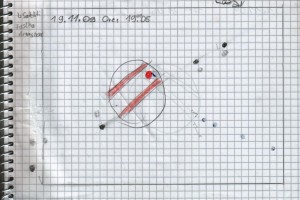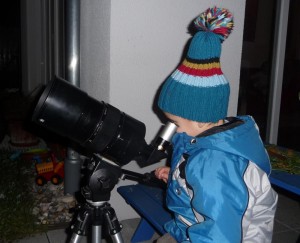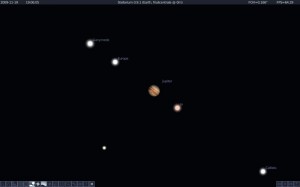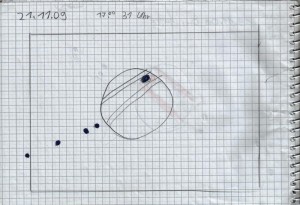Galilean Nights @ Home

A long concealed book
November 19, 2009
Catastrophic Explosions seen through Interstellar Clouds
November 26, 2009This has been an “all-astronomy” week-end. It started when I got back from the office. I had promised my kids we would have watched Jupiter and its satellites early in the evening. And so we did. In the days before we had done some preliminary attempt, using my old, beloved f/10 MTO Maksutov. Jupiter was around the meridian, just above the big, bright glow cast by the town of Munich (there will be a post on light pollution soon…). As a side effect, the kids experienced how disturbing street lights are.
So, when I got back home I found them ready in full astronomical gear, equipped with pencils and notebooks. The idea was to observe Jupiter and draw some sketches in subsequent nights, so to clearly see whether what Galileo had seen (and told us) was indeed right (this is the way I sold the experiment to them). They were very enthusiastic about it, especially the little one (3.5 years), who had his own concept of astronomical
observations. It took me quite a while to convince him that our target was high in the sky and not the window across the street (he said he was looking for Long John Silver, because Billy Bones had told him to beware of the man with one leg…). The girls (6 and 9) were more professional about it and took the whole business very seriously, sitting at the telescope, watching, drawing, re-observing and correcting the sketches. The seeing was not extremely good, and the colored stripes were visible from time to time across the disk of Jupiter. I left them alone for a while, so that they could observe at will. Once they asked me to point Vega, to see how it would look like. Nice comparison, indeed. They immediately saw the difference and I think this will stay with them for quite a while.

A sketch of Jupiter and its Galilean Satellites (20/11/2009, 19:05 CEST). Drawing by Costanza Patat. Note the orientation is reversed with respect to the Stellarium map.
When I came back (meanwhile the boy was running around in the garden), they had finished their homework. Impressively enough, the eldest had also put the Great Spot in her drawing. I admit I could not see it in the eyepiece, but she claimed she did. Later on, comparing her drawing with Stellarium, I noticed that, at least, the spot was visible and more or less in the same position as she had portrayed. However, two nights after she painted the Red Spot in the same position, while at the time of those observations the spot was not supposed to be visible…
Our astronomical session was interrupted by Mom calling for dinner. But we left the improvised observatory with the promise of re-observing Jupiter in the next nights, to see whether it would look any different.
My astronomical commitments for that evening were not over, though. At nine I had a videoconference planned. So, back in the office after dinner and ready to talk to an Italian group of amateurs of the Friulian Association for Astronomy and Metereology. I had sent them the keynote presentation in the afternoon and the idea was to have a Skype session. They would run the presentation and I would comment it live. Although not exactly the same as being in front of the public (something I enjoy very much), the thing worked rather fine. The talk was about my last trip to Paranal, the commissioning of X-Shooter and the life of an experimental astronomer in general. At 22:30 the conference was over and I got back home. All little astronomers were deeply sleeping. Observing the smallest I could not tell whether he was dreaming about Jupiter or Jim Hawkins (his favorite in these days).
On the next evening, the kids were ready around 17. The configuration of the satellites was a very interesting one. All four were on one side of the planet. But most important, Io would disappear behind the big planet in about 45 minutes. This would offer the kids the chance of seeing the system evolving just under their eyes (and well before dinner’s time). Before starting with Jupiter we pointed the young, crescent Moon. It was wonderful and the kids were delighted to look at the craters. In particular, the peak of a mountain on one edge of the terminator was shining in the middle of a dark area. It was not the first time they saw the Moon with a telescope (during summer vacations we always have some observing session with friends). Nevertheless, they looked thrilled. When they were satisfied with the Moon it was the turn of Jupiter. They were looking forward to see it and to compare the image in the eyepiece with the drawings they had obtained during the previous observations). And, yes! They could immediately see that something had changed and that, in particular, one of the satellites (Io, as it turns out), was very close to the disk of Jupiter. Their wonder grew during the next hour, as the satellite was getting closer and closer, to disappear behind the planet around 18:50 CEST. I must confess I was excited too. It is only with a direct experience that you can fully understand what it must have been for Galileo during those memorable nights in Padua, back in January 1610.
The plan for the evening moved towards a more [G]astronomical context. The day before I had announced an home-made Mexican dinner to close the observations. And so was it. Fajitas, nachos, hot deeps and so on. A glorious evening!





5 Comments
Great entry!
I love to see the little scientists carefully drawing the moons of Jupiter like that. Thanks and keep it up 🙂
Carolina
Thanks!
Are professional observing sessions ever interrupted by “mom calling for dinner?”
I would love that 😉 No, during a “professional” observing session there are no such nice interruptions. One often eats during one long exposure, provided that there is somebody taking care of the telescope. Otherwise, a sandwich over the computer keyword…
Great post! For sure it was a very nice experience. Not just the dinner, of course… 🙂
Carlos.